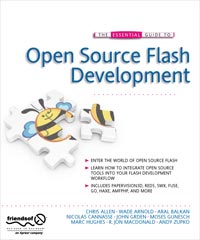Open Source Flash Development, book review by Weyert de Boer
6
The Flash community is one of those community where you get flooded with open source projects. In the book “The Essential Guide to Open Source Flash Development” the most popular projects are getting discussed. The book discusses projects such as AMFPHP, Papervision3D and Red5. The initial chapters 1-4 of the book explain how to get up-and-running with an open source development environment. This means that projects as MTASC, swfmill and the Adobe compilers are getting discussed in these chapters. Especially, how to prepare IDE such as FDT and FlashDevelop to leverage these solutions. After this you are ready to start working on your ActionScript2 or 3 project.
As you might know every Flash project is nothing without the right testing and debugging tools. In Chapter 5 several open source solutions for unit testing (AsUnit and FlexUnit), debugging (more logging, XRay) are discussed. Of course, other activities as debugging using breakpoints, watches are not spoken about, but these are already discussed in Adobe’s own documentation.
The more interesting chapters start after Chapter 6, which discusses deploying Flash projects using SWFObject.
In the chapters 7-8 opens source alternatives for remote communication are discussed using AMFPHP and SWX where is shown how you can make a products catalogue. Chapter 8 which about SWX also discusses how to make a Flash Lite version. At the end of the book a different solution called RED5 is discussed. Spread over two chapters a short introduction is given how to use Red5 and how you can use it to connect MIDI instruments together with your Flash project. This means you can create your own version of Guitar Hero!
In chapter 9 an alternative language called haXe is explained. haXe is computer language where the compiler can output to ActionScript byte-code. In the chapter is shown how it can be used to create Flash projects. Not only that but also the benefits (such as better optimised bytecode meaning your Flash project gets faster) of using the haXe compiler instead of the Adobe compilers. After reading this chapter you have the haXe IDE going and a good understanding of the differences between haXe and ActionScript.
Chapter 10 discusses two animation toolkits for tweening, Fuse and GoASAP. If you are looking for more information about how to do tweening, then you can better read one of Keith Peters’ book about movement and animation.
The Open Source Flash Development book is a nice introduction in several open source projects within the Flash Community while I think some chapters could discuss its chapter more thorough. The final result of the book is great and helps you getting started with these projects. Especially, the chapter about PaperVision 3D could be more in depth about the camera and its connection with the objects in the scene. Beside of that the book is packed with useful information to get your started.
Book Details:
Published: 14th July 2008
ISBN-10: 1-4302-0993-3
ISBN-13: 978-1-4302-0993-5
RRP: $46.99 (USD)
350 Pages





gooooooooood
Nice book